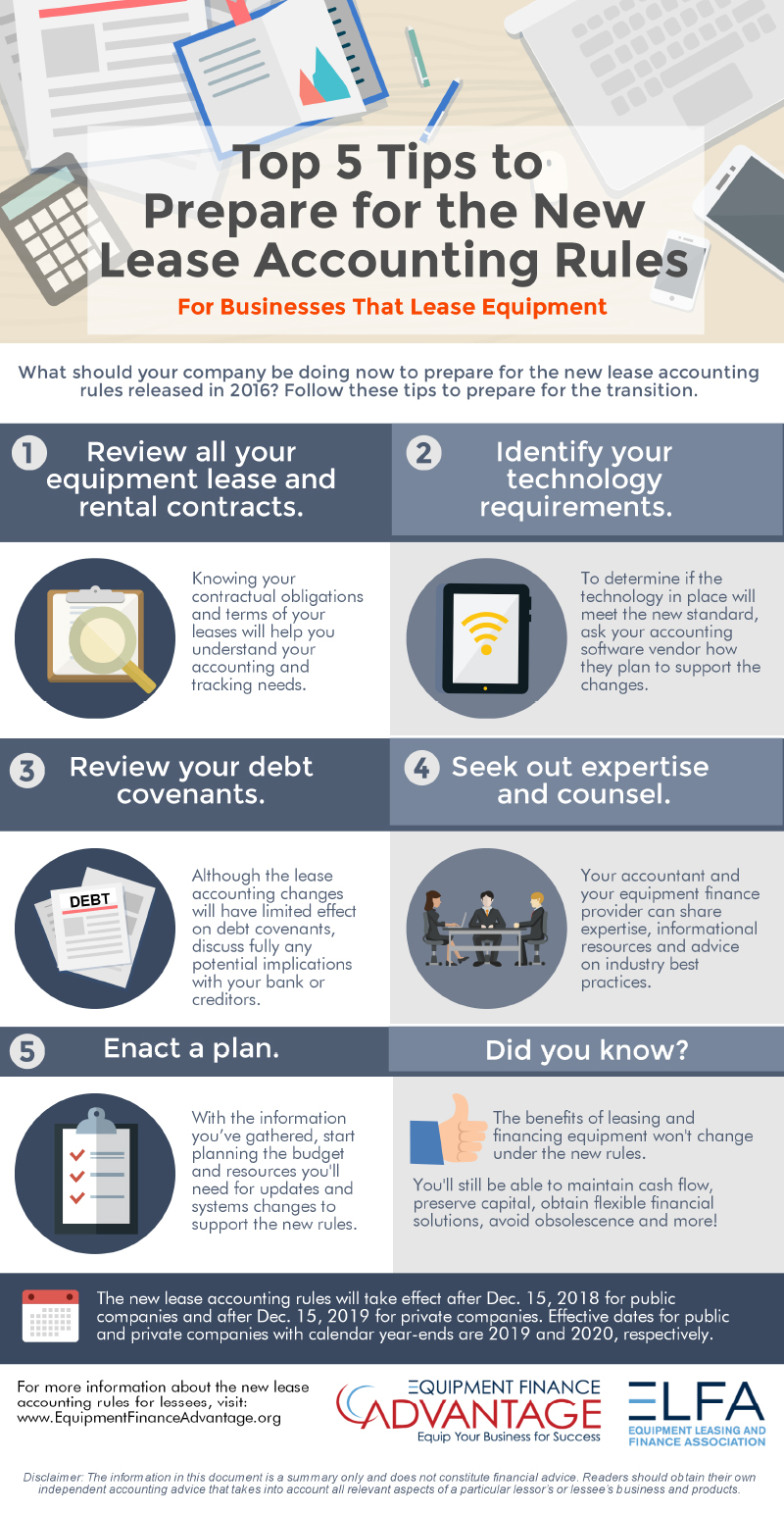8 Steps to Help Transition to the FASB Approved New Lease Accounting Rules

Looming deadlines require the wider organization to understand challenges and risks of the new standard, and how functions within the organization must adapt.
The new rules for lease accounting approved by the Financial Accounting Standards Board (FASB) are scheduled to take effect for financial periods starting after Dec. 15, 2018 for public companies and after Dec. 15, 2019 for private companies, with a modified application for any other financial period presented.
While organizations may be aware of the pending changes, many are not up to speed in their progress in transitioning to the new accounting standard, known as Accounting Standards Codification Topic 842 (ASC 842).
The new FASB standard will modify the accounting for all leases which are in effect during the transition period.
This means that although the standard applies to financial periods starting after December 15, 2018, it will require a restatement for the financial reporting of prior periods also.
Who Will Be Impacted
Lease accounting changes affect both lessee and lessor organizations. Many lessors also act in the capacity of a lessee and thus may have the need to have lessee-oriented lease accounting functionality in place. While lessee accounting will change much more so than lessor accounting, the analytical process that both lessees and lessors should go through may be similar.
Additionally, many lessors that are subsidiaries of other companies, such as banks and manufacturers, may be called upon by their parent organizations to assist in analyzing their own leases where they are acting as a lessee. Lastly, agreements other than leases will also be examined since they may very well be construed to either contain a lease or to be a lease under ASC 842.
Various surveys conducted after the new standard was approved showed that a majority of companies were only in the early stages of preparation to implement it. Another showed that less than 10 percent of companies have systems in place to comply with the new rules. Given that the new lease accounting rules may impact different parts of an organization, people will need to be engaged and policies, processes and procedures ramped up to meet the challenges.
Accordingly, the Equipment Leasing and Finance Association has compiled some high level steps that both lessees and lessors may consider following in the transition to the new lease accounting standard.
1. Start NOW. Initial steps should include budgeting time and resources to perform the work. This includes determining which resources will be sourced internally and which shall be outsourced.
The time estimated to make the transition is up to a year domestically and up to 24 months for a global program.
2. Designate the project team. This team will oversee the transition process, establish timelines and be responsible for timely, effective project completion. The team should be comprised of representatives that lease equipment, administer leases or use information regarding leases. The team is likely to come from the finance/treasury, lease administration, IT, accounting and business units.
Designate one owner for the equipment leasing program who is responsible for establishing uniform processes, policies and controls of leased equipment, and to act as executive sponsor. The team should also include individuals who understand or can identify the full scope of agreements that an entity may be involved with, not just those agreements described as leases.
3. Know the new rules. The project team as well as the wider organization should understand the new standard, including implementation deadlines, challenges and risks, and how functions within the organization must adapt to address them.
Training and informational sessions should be arranged as necessary.
4. Build a detailed implementation plan. The team should develop and have in place an initial and an updated plan of the steps to be undertaken for the transition.
These should identify deliverables and processes, including back scheduling from implementation deadlines to establish timelines.
5. Inventory all equipment leases, real estate leases and other agreements in a centralized, electronic repository. In addition to operating and capital/finance leases, there are other forms of existing agreements and contracts that may be construed to be leases that should also be identified.
These can include multiple-element arrangements that combine services, software, hardware and/or financing, and contracts such as power purchase agreements and supply contracts. All should be fully documented and compiled into similar categories for more efficient management and analysis.
This will help decide whether the organization should elect either of the two available practical expedients that must be applied consistently to all leases. This determination will apply not only to reporting existing leases and other agreements during the transition phase, but also determine future accounting policy decisions.
6. Prepare a high level “if, then” type of analysis. In the transition phase, it is key to determine the effects of whether or not to implement either or both of the two specific practical expedients. If elected, a practical expedient must be applied to all leases and agreements.
The first practical expedient can be called the “prior conclusions” practical expedient under which previous conclusions are respected while the new accounting is applied to those conclusions. So, if elected, an operating lease remains classified as an operating lease under ASC 842 but is nonetheless subject to being capitalized by the lessee.
Further, a service contract such as certain energy agreements, remain classified as such and are not subject to ASC 842. The other practical expedient is the “hindsight application” practical expedient, which allows one to use hindsight of activity which occurred during the transaction period in the application of ASC 842.
While simply electing both practical expedients may seem like a natural and relatively easy step to take, both lessors and lessees should examine their portfolios of leases and other agreements and determine the effect electing the practical expedients would have on the entity’s financial reporting. The if/then analysis can be conducted on a sample size of the various agreement categories identified in step 5.
7. Determine IT capabilities and requirements. Assess the organization’s existing IT structure and whether it can handle issues such as data extraction, information and document storage and the reporting requirements of the new standard.
Lessees may be challenged in their ability to account for the capitalized lease liability as a loan for all of their existing leases and agreements. Leveraging IT tools and support will enable the organization to better manage the transition, as well as equip your organization for post-transition lease accounting.
8. Identify gaps in performance and capabilities. Assess existing lease accounting policies, procedures, and controls and perform a gap analysis to determine which require changes.
Determine which options to follow to reach the desired future state of tracking and financial reporting for agreements subject to ASC 842.
About the Author
 Ralph Petta is President and CEO, Equipment Leasing and Finance Association (ELFA). Mr. Petta has been with ELFA since 1987. He was named chief operating officer in 2010 and previously served as vice president of Research & Industry Services. Before joining ELFA, he worked for nine years in the office of U.S. Senator Sam Nunn. Petta graduated from Syracuse University with a B.A. in political science.
Ralph Petta is President and CEO, Equipment Leasing and Finance Association (ELFA). Mr. Petta has been with ELFA since 1987. He was named chief operating officer in 2010 and previously served as vice president of Research & Industry Services. Before joining ELFA, he worked for nine years in the office of U.S. Senator Sam Nunn. Petta graduated from Syracuse University with a B.A. in political science.
Article Topics
Equipment Leasing and Finance Association News & Resources
8 Steps to Help Transition to the FASB Approved New Lease Accounting Rules 2015 Equipment Leasing & Finance U.S. Economic Outlook Top 10 Equipment Acquisition Trends for 2015Latest in Warehouse|DC
Spotlight Startup: Cart.com is Reimagining Logistics Walmart and Swisslog Expand Partnership with New Texas Facility Taking Stock of Today’s Robotics Market and What the Future Holds U.S. Manufacturing Gains Momentum After Another Strong Month Biden Gives Samsung $6.4 Billion For Texas Semiconductor Plants Walmart Unleashes Autonomous Lift Trucks at Four High-Tech DCs Plastic Pollution is a Problem Many Companies are Still Ignoring More Warehouse|DC













